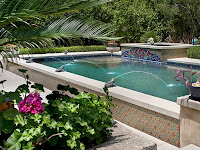Pool Plaster Issues and Defects
What is a normal plaster job and what is considered a defect in the plaster? Sometimes that is not an easy question to answer and I have seen much different plaster outcomes from various builders. I think the biggest takeaway is that you cannot achieve perfection in any type of finish, maybe one day when they have robots doing all the work. There will be some issues with your plaster no matter how you look at it so my suggestion to you is not to be overly picky.
What is a normal plaster job and what is
considered a defect in the plaster? Sometimes that is not an easy question to
answer and I have seen much different plaster outcomes from various builders. I
think the biggest takeaway is that you cannot achieve perfection in any type of
finish, maybe one day when they have robots doing all the work. There will be
some issues with your plaster no matter how you look at it so my suggestion to
you is not to be overly picky.
I have seen several problems caused by the improper filling of a plaster pool. Unlike Pebble Tec, Fiberglass, and Vinyl pools, plaster pools pose some significant issues even when you are just filling a newly plastered pool. It is basically like wet cement in the first few days. One thing you should never do is turn off the water before it is above the tile line. If you do, there is a big chance that you will have a ring around the entire pool, right where the water was turned off at. This ring of discolored plaster will be permanent. You also do not want to use the autofill to fill the pool. That line will leave a streak down the side of the plaster at the autofill outlet into the pool. Last, you want to make sure the hose you fill the pool with is wrapped in a towel and left in the deep end of the pool. Any failure of these points will leave some type of discoloration in the plaster.
Brushing the pool is also a critical step in a correct plaster start-up. But you only want to use a soft bristle brush, nylon, or poly bristles. These are the brush type of choice. Do not use any pool brush with Stainless Steel or wire bristles or this will leave permanent marks on the pool surface. You also do not want to put any type of vacuum in the pool for the first 3-4 weeks. If you vacuum the pool with your manual vacuum with wheels, chances are you will leave wheel marks in the plaster that may not come off until the pool is drained, and acid washed. Even using a leaf rake on the bottom can cause some marks if you are not careful. The only thing I suggest for the first week is brushing the pool with a nylon brush and doing nothing else.
I have seen some new plaster pools with dog footprints, kids’ hands and feet marks, and object marks on the surface and walls. While the plaster is curing you should not enter the pool and you should try your best to keep pets and kids out of the water. I wouldn’t get in the pool for the first 2-3 weeks and if you use the pool the first week prepare to leave some marks on the pool plaster. The best thing you can do is to keep the pool off-limits for the first 2-3 weeks. No pool toys in the pool and no swimming.
With a proper start-up and plenty of brushing, the plaster can feel very smooth but still be rough in many areas. I suggest if you have young children, maybe purchase some swim shoes for the first 6 months. The kids will likely be using the pool for hours on end and over time their feet and hands will get small abrasions to form the new plaster, causing bleeding. This is perfectly normal and almost all new plaster will do this to your feet and hands. After the plaster fully cures this won’t be an issue, but that could take up to 6 months.
Once the start-up is complete and the pool is full of water you should turn on the pump right away and start circulating the water. The only exception to this is if you are doing an Acid Start-Up, in that case, you need to raise the pH above 7.0 before turning on the pool pump. I suggest running the pool as much as possible the first week, 24/7 if possible. The more you run the pool the better the outcome. If you have a variable speed pump, I suggest running it at the full 3450 RPM for the first week. I have seen pools that were running 24/7 the first week and others set to run 8-10 hours and the results were like night and day. Less mottling and less plaster dust sticking to the surface.
Visit my Website: http://www.swimmingpoollearning.com/
eBook: https://www.swimmingpoollearning.com/swimming-pool-care-ebook
YouTube Video Index: http://poolmandave.blogspot.com/2014/03/swimming-pool-tips-reviews-how-to-video.html – A list of all of my videos.
Blogger: http://poolmandave.blogspot.com/
Facebook: https://www.facebook.com/swimmingpoollearning/
Twitter: https://twitter.com/Mrdgvb1
Join me on Patreon: https://www.patreon.com/poolguycoaching
Podcast: http://www.buzzsprout.com/110832
Podcast Website: https://www.thepoolguypodcastshow.com/
Coaching Site: https://poolguycoaching.com/
Shop at Leslie's: Leslie’s Pool Supplies has been do-it-yourselfers and pool trade professionals trusted partner since 1963, providing quality products and services to make pool care easy and solutions and expertise to do it right. http://lesliespool.com/?utm_medium=referral&utm_source=spll&utm_campaign=spll

Comments
Post a Comment